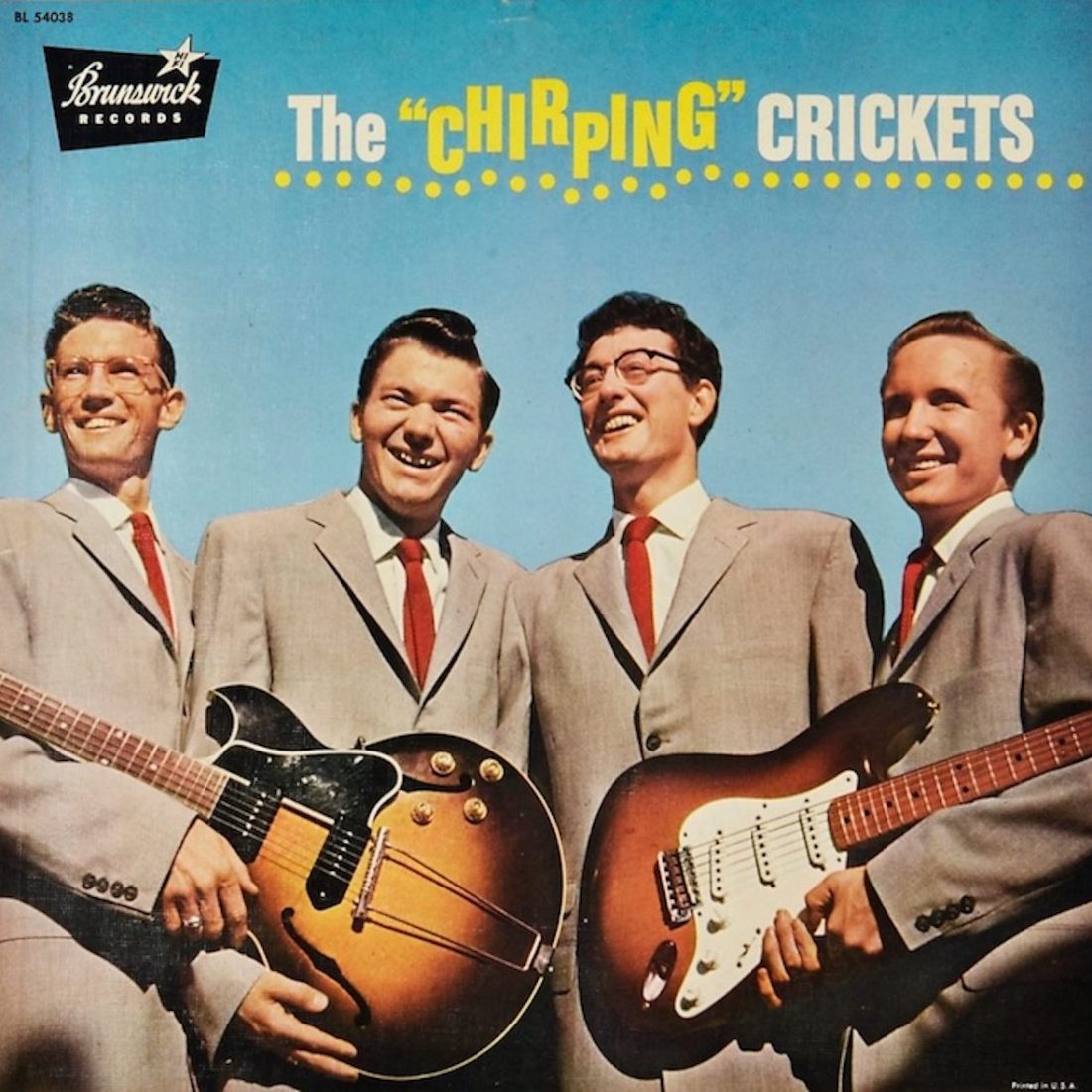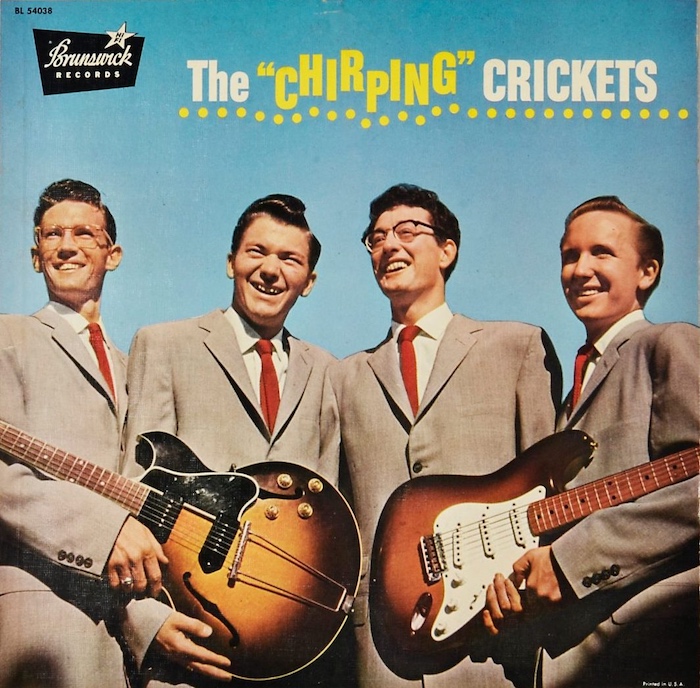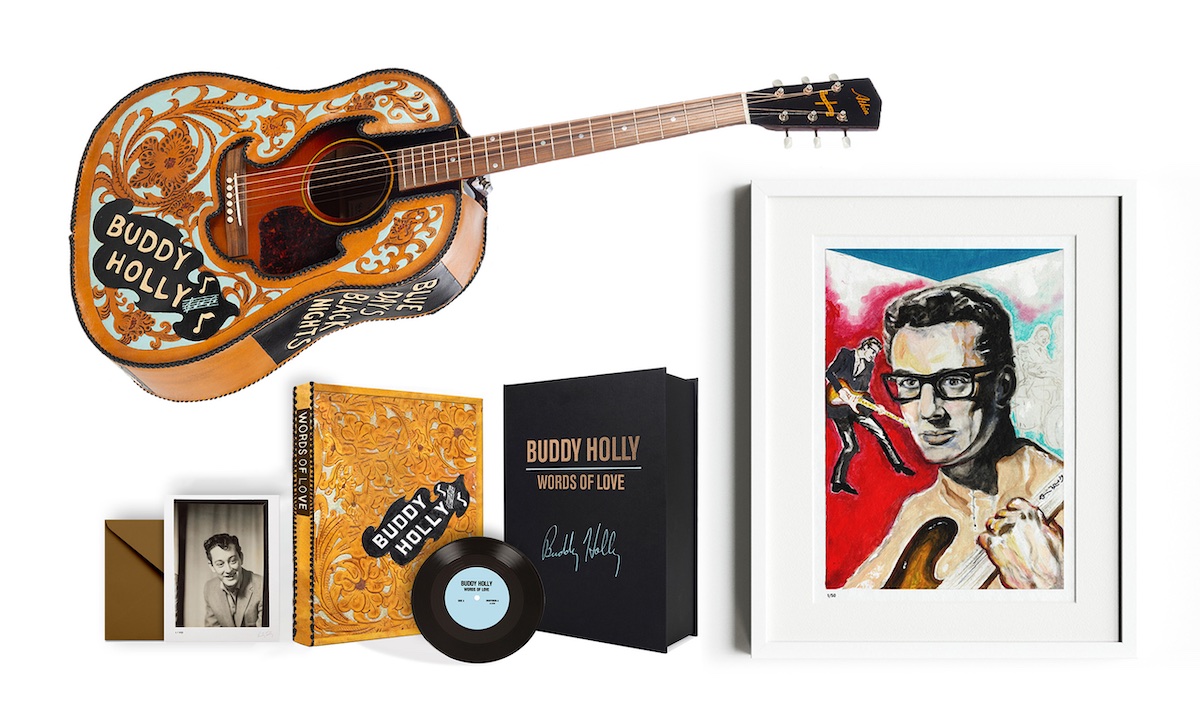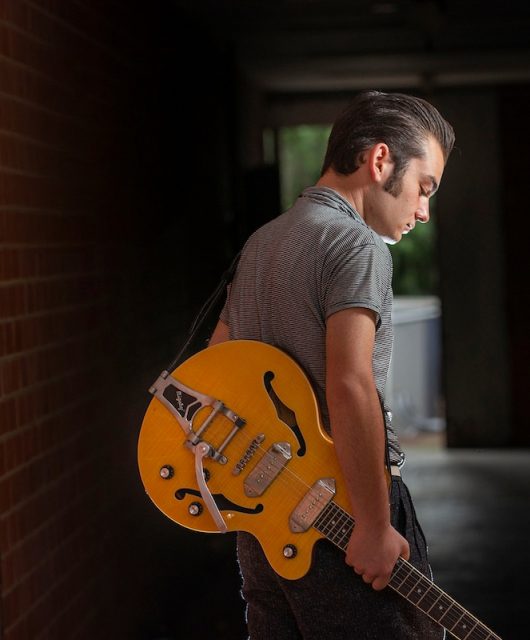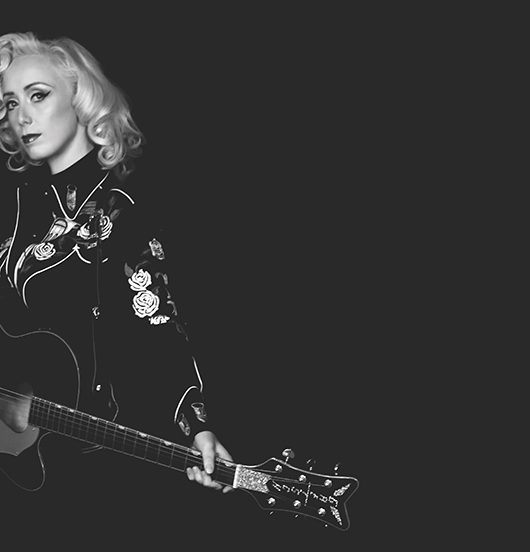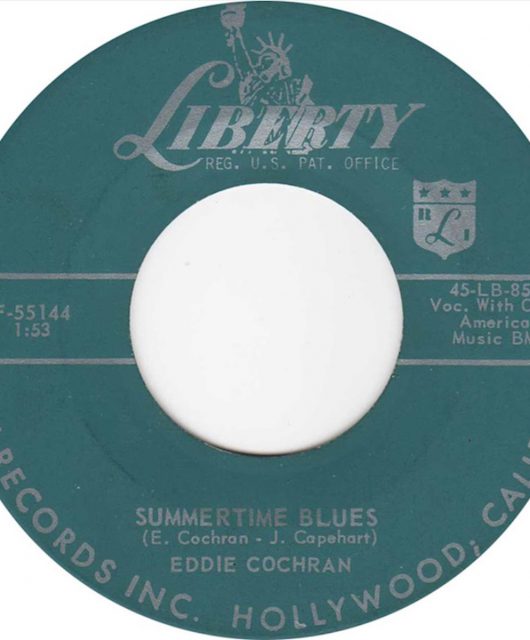Words of Love – The Buddy Holly Story: In 2022, just a couple of months before Jerry Allison passed away at the age of 82, Vintage Rock talked with the Crickets’ drummer about Buddy Holly’s lasting legacy. We also spoke with Buddy’s widow, María Elena, as well as founder member of The Shadows, Bruce Welch…
It’s remarkable to think that only 16 months separate Buddy Holly & The Crickets’ That’ll Be The Day landing in the UK Top 20 and the singer’s untimely death at the age of 22. It’s perfectly reasonable to suggest that no other artist in the history of popular music has ever left such a lasting impression on popular culture, in such a short period of time as Buddy did with his bandmates Jerry Allison and Joe B. Mauldin.
Having recorded some of the most beautifully crafted, life-affirming songs of all time, Holly and The Crickets influenced legions that followed.
That’ll Be The Day
Keith Richards, whose Rolling Stones scored their first UK Top 5 hit with a cover of Not Fade Away, proclaimed that The Crickets were: “the first global, international rock band of all time”, when he inducted them into the Musicians Hall of Fame in 2008. “These guys wrote them, sang them and recorded them,” said Richards. “There would probably be no Beatles or Rolling Stones without them.”
Famously, The Quarrymen featuring a pre-Beatles John Lennon, Paul McCartney and George Harrison, made their first recording with a demo of That’ll Be The Day in 1958. The track would provide a template for the fledgling Fab Four to replicate on early hits like Love Me Do, Please Please Me and She Loves You. Lennon even confessed to naming The Beatles after The Crickets.
Macca himself had such an affinity with Buddy’s music, that he would go on to own it when his company McCartney Productions Ltd bought the publishing rights in the late 70s, and would later acknowledge: “John and I started to write because of Buddy Holly.”
Country Roots
Charles Hardin Holley was born into a musical family of devout Baptists in the West Texas town of Lubbock on 7 September 1936. Nicknamed ‘Buddy’ from childhood and the youngest of four children, the future rock’n’roll pioneer would absorb the music of Hank Williams, Jimmie Rodgers, Hank Snow, Bob Wills, and the Carter Family during his formative years.
Brother Larry Holley, who passed away in April this year, revealed in the 2017 BBC documentary Rave On, how his younger sibling was drawn to the guitar at an early age: “Buddy came to me and said, ‘Larry, I need a guitar.’ I said, ‘You can’t play one.’ He said, ‘I can learn…’ As soon as he got it in his hands, it sounded like a different instrument completely.”
Over in Hillsboro, future bandmate Jerry Allison moved to Plainview with his family as an infant before settling in Lubbock.
A Lubbock Lad
“I started playing music after I went to a football game when I was in the fifth grade,” Jerry tells Vintage Rock. “I saw the band marching and playing, and thought that it looked like fun. So, I went to the band director and asked if I could join, he said, ‘Well, can you go boom-chick-boom, stamp your feet, and clap your hands?’ I said I could… so I decided I wanted to learn how to play drums. It wasn’t too long after that my folks bought me my first drum kit, a Slingerland set, which wasn’t too hot because it was really old and had leather skins. That’s pretty much how it all started for me, though.
“I first became aware of Buddy when I was in the seventh or eighth grade. He was a little older than me and we wouldn’t become friends until we were in high school. Buddy had been playing with Bob Montgomery, as Buddy & Bob, and I’d started with a band called The Riverside Ranch Hands, performing cowboy covers. Buddy would often come along and sit in on our sets. He eventually asked me to play drums with him and soon became my best friend.
Audience With The King
“Our group at the time included Sonny Curtis on fiddle and guitar, Don Guess on pedal steel, and a fella named Larry Welborn played the bass. We all liked country music, but Buddy and I loved the music of Chuck Berry, Fats Domino, Bill Haley and, of course, Elvis. Presley had such a big influence on us.
“After he first came to town, Sonny started playing guitar like Scotty Moore and Buddy began singing like Elvis. But Elvis didn’t have a drummer at that time, so I was left out for a bit, until he returned with D.J. Fontana, and then I was back in. We were all Elvis fans, but Buddy wanted to be Elvis.”
After graduating from Lubbock High School in May 1955 and having opened for his hero Elvis, Holly decided to pursue a full-time career in music. Jerry explains: “Buddy and I wanted to be in a rock’n’roll band. We would play a lot around Lubbock, often just the two of us, which was fine because we made more money [chuckles].
“Sonny started to join us at some of those gigs and we asked Joe B Mauldin if he wanted to play bass at a show in Carlsbad, New Mexico. Joe B was in a group called the Four Teens at the time, but on the way back from Carlsbad we asked if he wanted to join our band. I remember him pausing before saying he would as long as it didn’t interfere with his school, his job or being in his other group.
“We continued to play around Lubbock and had some friends that would come along and watch, but very soon things picked up for us.”
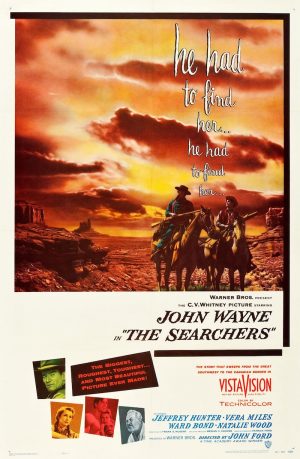
Holly-wood Inspiration
In October 1955, Buddy was spotted opening for Bill Haley & His Comets by Nashville scout Eddie Crandall, and a few months later, in January 1956, Decca Records presented the singer with a contract. However, the label misspelled his surname and ‘Buddy Holly’ was born.
On 26 January 1956 Holly attended his first recording session for Decca with Curtis, Guess and session players, guitarist Grady Martin and percussionist Doug Kirkham, to record his debut single Love Me/Blue Days, Black Nights.
Acclaimed for his work with country queen Patsy Cline, Owen Bradley directed proceedings but the partnership did not prove entirely successful for Buddy, with the producer controlling both the studio and sound. He returned to Bradley’s Barn in July with Curtis, Guess, Allison and a song he had co-written with his drummer. It would be that song which would, eventually, help rewrite rock’n’roll history.
“We’d been to the theatre to see a John Wayne movie called The Searchers,” Jerry recalls, “and Wayne’s character must’ve repeated the line, ‘That’ll be the day’, five times. Buddy and I were in my bedroom rehearsing because I had a piano and my drum kit set up. Buddy said, ‘We ought to write a song’, and I jokingly mimicked the Duke’s ‘That’ll be the day’ line, and Buddy said, ‘That’s a good idea!’ Within 30 minutes we had That’ll Be The Day. We took the song to Nashville and recorded it with Owen, because Buddy had that deal with Decca, but I think the country music folk hated it.”
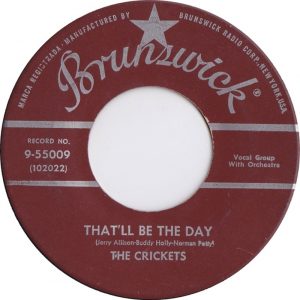
Genius Producer
A further Nashville session in November 1956, featuring Farris Coursey on drums, E.R. McMillin on sax and the celebrated piano player Floyd Cramer, spawned the Bradley-produced single Modern Don Juan/You Are My One Desire.
Again, like Buddy’s debut release, it failed to make an impression on the charts and Decca told the singer his contract would not be renewed. “We started playing That’ll Be The Day at gigs around town and everyone seemed to like it,” Jerry continues. “So, we decided to record it again. This time we took it to Norman Petty’s studios in Clovis. I don’t know where Joe B was when we made That’ll Be The Day with Norman, because Larry played bass on it.”
In 1957, bolstered by Niki Sullivan on rhythm guitar, Holly, Allison and Mauldin recorded the tracks which would make up The “Chirping” Crickets album with Norman Petty between 25 February and 29 September. While Petty proved to be something of an inventive maverick in the studio and a genius producer, part of his deal was that his name appeared as a co-songwriter on their releases.
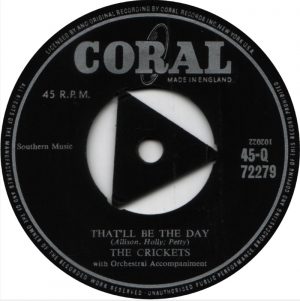
Chirping Crickets
“I’m still terribly disappointed that Petty put his name down as one of the writers on That’ll Be The Day,” Jerry admits, “because it was our song – Buddy and me. We wanted all our families and friends to know that it was ours… I still complain about it all these years later.”
A clause in the contract that Holly had signed with Decca prohibited Buddy from re-recording any of the songs from those earlier Nashville sessions for five years. To bypass this restriction, Petty proposed using a band name on his reworking of That’ll Be The Day, which had been picked up by Brunswick Records, a subsidiary of Decca, in New York. It was Allison who suggested ‘The Crickets’.
“There was a group called The Spiders who had this song we liked,” recalls Jerry, “so we thought ‘let’s name ourselves after an insect’. That year Lubbock had been infested by crickets… man, they got everywhere.”
It was only a matter of time before the name Buddy Holly & The Crickets would also be appearing everywhere…
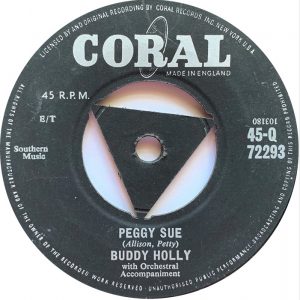
Bowling Over The Brits
“Buddy, Joe B, Niki and I played our first tour, and we had so much fun,” remembers Allison. “We were making more money than our parents, so that made us really happy. Everywhere we turned up people thought we were going to be a Black group because there had been a R&B act called The Crickets from New York. We loved that because we were such big fans of Black artists like Chuck Berry and Fats Domino.
“Most touring performers would use a back-up band or an orchestra, so when acts like our great friends The Everly Brothers played their songs, such as Wake Up Little Susie or Bye Bye Love, they didn’t sound quite right. We immediately had an advantage because we could get up on stage and sound just like our record.
“Touring didn’t sit well with Niki and he dropped out, so it ended up being just Buddy, Joe B and me. When we first started out, our goals were simple: to go to New York, do a real tour with someone like Fats Domino and see our name in a music magazine like Billboard or Cashbox. When That’ll Be The Day began to get played by different radio stations, and people started to like us, we were as surprised as anyone!”
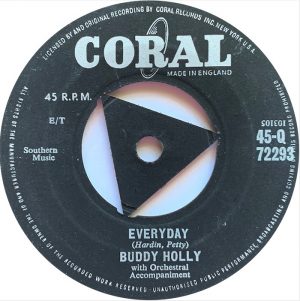
Something Else
The Brunswick single rose up the Billboard Best Sellers chart in 1957, eventually reaching No.1 as well as making No.2 on the R&B chart. Entering the UK Top 20 at No.12 on 3 October 1957, it climbed to the top spot and remained there for three weeks. “We couldn’t believe that it made the Top 10 in the UK, never mind No.1.” smiles Allison.
“The folk over there in the UK were just so nice to us when we toured in 1958. I think Bill Haley had been the only rock’n’roller to visit before us, but he was a little more on the country side, so we were totally different to anybody that had come before. That made every night a highlight for us because, in America, audiences were so used to rock’n’roll. Over in the UK the kids just hadn’t experienced anything like us before and they were just noisier, happier and better!
“It was also great to play the UK because most of the shows we were doing in the US with Alan Freed were big package tours and we only got to play about four songs. In the UK, we had a full 30 minutes. I remember Liverpool being a special one, as was the London Palladium where Bob Hope appeared on the bill. We loved all the history and visiting places like Stonehenge, but the most memorable moments were the concerts and fans.”
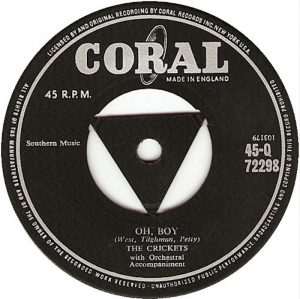
Revolution Rock
“English people just fell in love with Buddy straight away,” confirms one such fan, Bruce Welch. “I’d say Buddy Holly & The Crickets were probably bigger here than they were in America.”
The music of Buddy Holly had a profound effect on Welch, as it did countless other like-minded teens across the UK. The guitarist and founding member of The Shadows tells Vintage Rock: “When we were growing up, Hank Marvin and I formed a skiffle band because Lonnie Donegan was the king here. However, everything changed between ’56 and ’57 when rock’n’roll arrived. Everybody switched from being a skiffler to a rocker. On leaving school aged 16, Hank and I set off for London and we missed out on seeing Buddy in Newcastle on that UK tour… I’ve kicked myself ever since.
“The first song I remember hearing by Buddy Holly was That’ll Be The Day . It is such a massive song, but so-so simple and effective – like all his early numbers are. Hank and I started writing our own material because of Buddy. It sounded like nothing you’d ever heard before; you listen to it now and it still sounds just as fresh. That fantastic intro Holly plays is so brilliant. Hank and I were only learning guitar at the time and had no idea that Holly used a capo, we didn’t even know what a capo was, so it took us a long time until we figured it out – I’m 80 and I think I’ve learnt it now [laughs].”
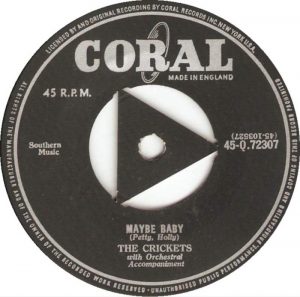
Into The Stratosphere
“Buddy was the first with a Stratocaster and none of us had ever seen one before,” Welch continues. “When I finally saw a photo of Buddy with his guitar on the front of The “Chirping” Crickets album, I thought ‘f*ck me, what is that!? It looks like a spaceship! I gotta get one of those… whatever it is!’
“His music was so infectious and joyous. He had such an instantly recognisable voice, with that unique hiccuping style, you knew straight away it was Buddy when you heard him on the radio. That’s a huge asset for any recording artist.
“Everybody copied Buddy, he was just magic. His music makes me feel so happy and brings back a lot of wonderful memories. I became a better player because I listened to Buddy Holly.”
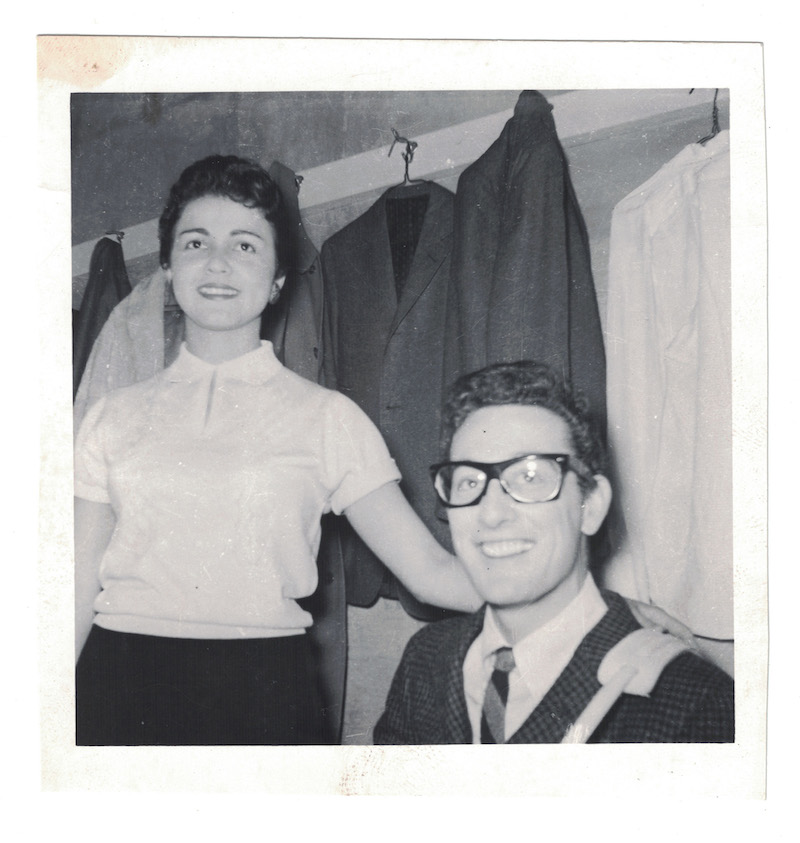
It’s So Easy To Fall In Love…
As fans around the world fell in love with the music of Buddy Holly And The Crickets, Buddy’s own heart was about to be taken by a young receptionist at Peermusic.
“My Aunt Provi was head of the Latin music department at Peer Music in New York,” María Elena Holly tells Vintage Rock. “In the summer of 1958, she asked if I could go in to help out on reception. I’d only been there a few days when Buddy and The Crickets happened to drop in because Peer was their publishing company. Buddy started talking to me and I found him absolutely charming. He was engaging and amusing, with a warm but confident personality.”
It was during this first encounter that Holly asked María Elena out for dinner. She told him he would have to ask her aunt if it was acceptable first. A smitten Holly promptly sought permission and would propose marriage on that very first date at P.J. Clarke’s in Manhattan. On 15 August 1958, the happy couple married at Tabernacle Baptist Church in Lubbock.
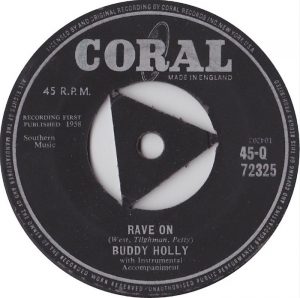
True Love Ways
María Elena smiles: “True Love Ways was written as a wedding surprise for me and it’s my favourite Buddy song. While I had aspirations of becoming a professional dancer, Buddy unexpectedly swept me off my feet and into the wonderful, crazy world of being the wife of a huge rock’n’roll star.
“He was very level-headed and quite reserved off stage but became totally focused and energised once he was performing. My memories of being on tour with Buddy and The Crickets are that they were a very tight musical unit: Buddy, J.I. and Joe B were close, fun-loving friends, who really enjoyed exciting their audiences.
“Buddy was always grateful that so many fans loved the music, and never took fame for granted, knowing it could be fickle and uncertain. That’s why he was always exploring new ways of expressing his music.
“He was looking forward to developing land he’d purchased in Lubbock to build a state-of-the-art music studio complex with living accommodation. Sadly, this was not to be.”
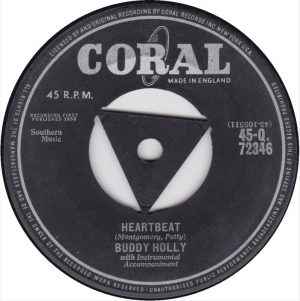
Taken Too Soon
Following the success of That’ll Be The Day, Holly was a constant fixture in the UK Top 10 with Peggy Sue/Everyday (No.6), Oh, Boy!/Not Fade Away (No.3), Maybe Baby/Tell Me How (No.4), and Rave On/Take Your Time (No.5).
However, by December 1958, Holly had split from Petty and amicably parted ways with both Allison and Mauldin. While The Crickets preferred not to leave their home state, Holly and his new wife María Elena moved from Lubbock to New York’s vibrant Greenwich Village. Due to growing legal and financial issues resulting from his break from Petty, Holly agreed to a tour through the Midwest with The Winter Dance Party.
Starting in Milwaukee, Wisconsin, on 23 January 1959, the tour abruptly ended in tragedy on 3 February 1959, after a show in Clear Lake, Iowa, when a specially chartered airplane crashed shortly after take-off, killing Holly, Ritchie Valens, The Big Bopper, and pilot Roger Peterson.
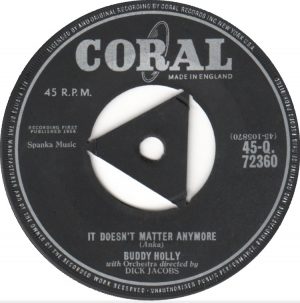
Tragic Loss
“Cliff and The Shads played the Municipal Coliseum in Lubbock, when we were guests in America on the 1960 Tour Of Stars,” Bruce Welch reflects. “It was a massive bill with Frankie Avalon, The Drifters and Johnny & The Hurricanes. By then, Hank looked like Buddy: he was tall and slim, had the red Stratocaster and wore the horn-rimmed glasses… so when we got up on stage the whole place went eerily quiet. I will never forget it.”
For one whose career was so fleeting, the impact Holly and his music made was immeasurable. While bereft fans are still left wondering what might’ve been, we know a reconciliation with The Crickets was on the cards, as was a return trip to the UK.
Allison explains: “Waylon Jennings, who was playing bass with Buddy on his last tour before the airplane crashed, told me a long time ago that Buddy had said the first thing he wanted to do after that tour was get backwith Joe B and myself and play England again. When Waylon told me that, I was like, ‘Oh man’, because we were trying to get back with Buddy, too.
“I always wish he hadn’t done that last tour and I think I would’ve been able to talk Buddy outta getting on that plane. We would have got back together and come back to England. I still miss Buddy, just like I miss Joe B who passed away in 2015.”
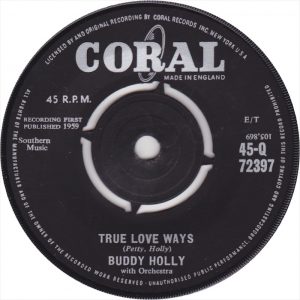
A Special Place
Buddy’s widow, María Elena Holly, adds: “Buddy enthused about the music scene in the UK, the incredible reception that he and The Crickets received from the fans at every concert, and how he planned to return very soon. He even discussed with me the possibility of opening a studio in London where he could collaborate with some of the great UK artists he’d been mixing with and listened to on that tour.
“What wonderful, exciting music may have been created in those sessions we can but dream about. For me personally, the UK holds a very special place in my heart, the loyalty of the fans over all these years to Buddy and The Crickets’ music, and the affection they have bestowed on me has been, and still is, incredible.”
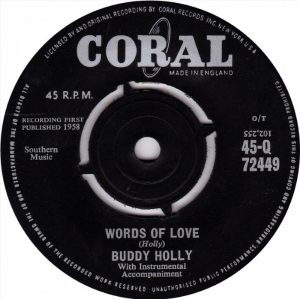
Not Fade Away
In 2010, María Elena co-founded The Buddy Holly Educational Foundation with Peter Bradley Snr., whose whole life changed when he heard That’ll Be The Day booming from a fairground attraction in Scarborough as a youngster.
Today the organisation looks to help preserve Holly’s legacy by promoting his music and actively supports the next generation of artists with songwriting retreats and scholarships. Peter Bradley Jnr. explains: “My dad and María Elena first met at what would’ve been Buddy’s 75th birthday when a star was placed on the Hollywood Walk of Fame. She immediately recognised my dad’s honest passion and earnest enthusiasm. She has become an extremely close family friend over the years and trusted us to help her pass on Buddy’s image and likeness rights to BMG after diligently managing them for decades.
“It’s very important that young people are made aware of these great artists because they can so easily disappear and be forgotten about. A movie reignites the flame and, as we have so many untold stories that María Elena has shared with us, we’re sure the film will spark that interest.
“We were also very close to Larry Holley, who recently passed away. He would be very proud that his little brother’s legacy was continuing to be spoken about like this.”
Laying The Foundation
María Elena enthuses: “I’m delighted at the way the foundation is evolving into such a significant institution. I am proud for Buddy that this not-for-profit charity, named in his honour, is helping so many worthy causes. Peter and his son have supported me steadfastly and helped ensure the goals we set out to achieve are carried out with integrity and care, especially our partnerships with Teen Cancer UK and Teen Cancer America.
“The foundation also helped me compile the Words Of Love book, which will see the proceeds from sales go direct to these two charities. The book includes handwritten quotes from many of the world’s greatest artists expressing how Buddy and The Crickets inspired them.
“I also know Buddy would have fully endorsed the incredible songwriting events they’ve set up. One of his great passions was songwriting, and he often discussed with me his vision to provide facilities where aspiring singer-songwriters, from whatever ethnicity or background, could learn the craft and hone their skills.
Words Of Love
“One of the proudest moments I have for Buddy’s legacy, is when I stood watching the foundation stone being laid for what was to become the sensational Buddy Holly Hall Of Arts And Science in Lubbock.
“Buddy would be so proud and amazed that, after all this time, there is so much fondness for his music. He was a humble man and the phenomenal success of The Beatles, Rolling Stones and other greats who acknowledge how Buddy and The Crickets influenced their careers, would have been quite unbelievable to him. I truly believe, many of the recordings still sound just as exciting as when they were first released, and the music they gifted to the world will continue to be enjoyed by future generations. I will, of course, always feel a sadness when I hear a Buddy recording, but grateful that his music still brings so much happiness and pleasure.”
“Nowadays,” Allison smiles, “if I hear our music on the radio, television, or in a movie, I grin… the biggest possible grin.”
For more on the The Buddy Holly Educational Foundation click here
Vintage Rock Presents: Buddy Holly & The Day The Music Died

